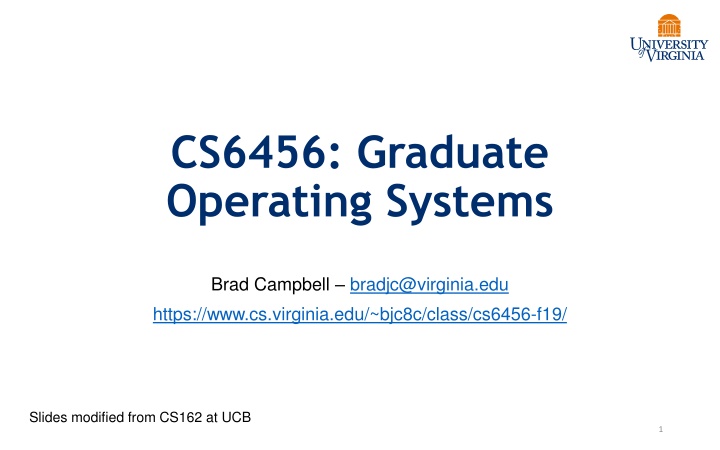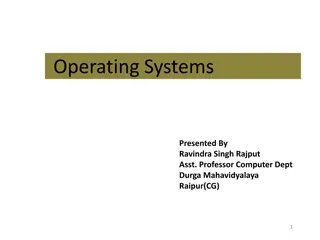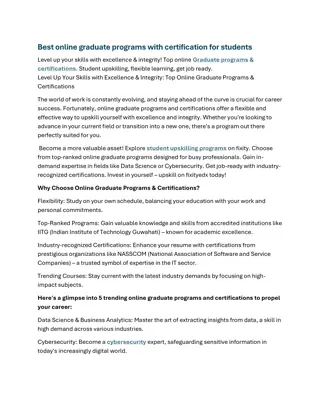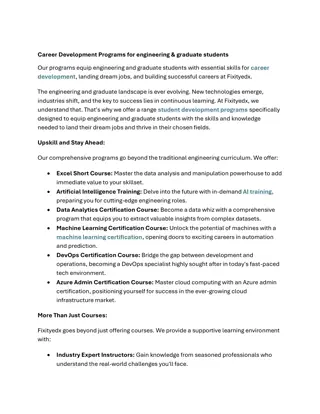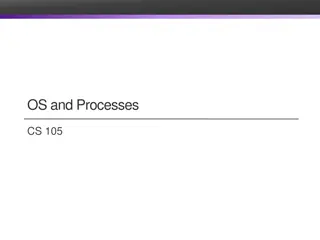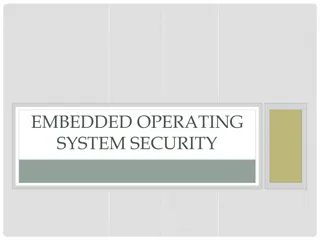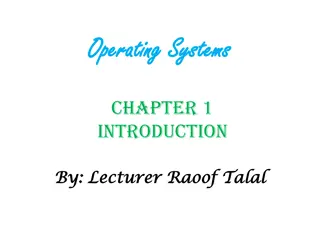Graduate Operating Systems Overview
This content discusses key concepts in graduate operating systems, such as processes vs threads, multiprocessing vs multiprogramming, and thread execution mechanisms. It explores the concurrency aspect in operating systems and details on how threads are started, managed, and executed. The material also covers bootstrapping threads and the lifecycle of a thread within an operating system environment.
Download Presentation

Please find below an Image/Link to download the presentation.
The content on the website is provided AS IS for your information and personal use only. It may not be sold, licensed, or shared on other websites without obtaining consent from the author.If you encounter any issues during the download, it is possible that the publisher has removed the file from their server.
You are allowed to download the files provided on this website for personal or commercial use, subject to the condition that they are used lawfully. All files are the property of their respective owners.
The content on the website is provided AS IS for your information and personal use only. It may not be sold, licensed, or shared on other websites without obtaining consent from the author.
E N D
Presentation Transcript
CS6456: Graduate Operating Systems Brad Campbell bradjc@virginia.edu https://www.cs.virginia.edu/~bjc8c/class/cs6456-f19/ Slides modified from CS162 at UCB 1
Processes vs. Threads Process 1 threads Process N threads Switch overhead: Same process: low Different proc: high Protection Same proc: low Different proc: high Sharing overhead Same proc: low Different proc: high Mem. Mem. IO state IO state CPU stat e CPU stat e CPU stat e CPU stat e CPU sched. OS 4 threads at a time Core 1 Core 4 Core 2 Core 3 2
Multiprocessing vs Multiprogramming Multiprocessing: Multiple cores Multiprogramming: Multiple jobs/processes Multithreading: Multiple threads/processes What does it mean to run two threads concurrently? Scheduler is free to run threads in any order and interleaving A B C Multiprocessing A B C A B C A B C B Multiprogramming 5
Today Going to talk about concurrency! But, need some mechanism to enable running different code simultaneously Therefore...threads! 6
How does a thread get started? Can't call switch() without starting a thread How do we make a newthread? Other Thread ThreadRoot A SetupNewThread(tNew) { TCB[tNew].regs.sp = newStack; TCB[tNew].regs.retpc = &ThreadRoot; } Stack growth B(while) yield New Thread run_new_thread switch ThreadRoot stub 7
How does a thread get started? So when does the new thread really start executing? Other Thread ThreadRoot A run_new_thread() selects this thread's TCB, "returns" into beginning of ThreadRoot Stack growth B(while) yield New Thread run_new_thread switch ThreadRoot stub 8
Bootstrapping Threads: ThreadRoot ThreadRoot() { DoStartupHousekeeping(); UserModeSwitch(); /* enter user mode */ call fcnPtr(fcnArgPtr); ThreadFinish(); } Stack growth ThreadRoot *fcnPtr Running Stack Stack will grow and shrink with execution of thread ThreadRoot() never returns ThreadFinish() destroys thread, invokes scheduler 9
Preempting a Thread What happens if thread never does any I/O, never waits, and never yields control? Must find way that dispatcher can regain control! Interrupts: signals from hardware or software that stop the running code and jump to kernel Timer: like an alarm clock that goes off every some milliseconds (tick) Interrupt is a hardware-invoked mode switch Handled immediately, no scheduling required 11
Example: Network Interrupt Raise priority (set mask) Reenable All Ints Save registers Dispatch to Handler ... $r1,$r2,$r3 $r4,$r1,#4 $r4,$r4,#2 ... add subi slli Pipeline Flush Interrupt Handler External Interrupt Transfer Network Packet from hardware to Kernel Buffers Restore registers Clear current Int Disable All Ints Restore priority (clear Mask) RTI ... $r2,0($r4) $r3,4($r4) $r2,$r2,$r3 8($r4),$r2 ... lw lw add sw An interrupt is a hardware-invoked context switch No separate step to choose what to run next Always run the interrupt handler immediately 12
Switching Threads from Interrupts Prevent thread from running forever with timer interrupt Some Routine Stack growth Interrupt TimerInterrupt run_new_thread switch TimerInterrupt() { DoPeriodicHouseKeeping(); run_new_thread(); } Same thing from IO interrupts Example: immediately start process waiting for keypress 13
So Far: Kernel-Supported Threads Each thread has a thread control block CPU registers, including PC, pointer to stack Scheduling info: priority, etc. Pointer to Process control block OS scheduler uses TCBs, not PCBs 14
User-Mode Threads User program contains its own scheduler Several user threads per kernel thread User threads may be scheduled non-preemptively Only switch on yield Context switches cheaper Copy registers and jump (switch in userspace) 17
User-Mode Threads: Problems One user-level thread blocks on I/O: they all do Kernel cannot adjust scheduling among threads it doesn t know about Multiple Cores? Can't completely avoid blocking (syscalls, page fault) Solution: Scheduler Activations Have kernel inform user-level scheduler when a thread blocks 18
Some Threading Models Simple One-to-One Threading Model Almost all current implementations Many-to-One Many-to-Many 19
Thread abstractionand its limitations Illusion: Infinite number of processors Reality: Threads execute with variable speed Programs must be designed to work with any schedule 20
Possible executions due to multiprogramming A B C A B C A B C B Multiprogramming Scheduler can run threads in any order And with multiple cores: Even more interleaving Could truly be running at the same time 22
Remember: Multiprogramming A B C A B C A B C B Multiprogramming Scheduler can run threads in any order And with multiple cores: Even more interleaving Could truly be running at the same time 24
Race Conditions What are the possible values of x below? Initially x = y = 0; Thread B Thread A y = 2; x = y + 1; y = y * 2; 1 or 3 or 5 (non-deterministic) Race Condition: Thread A races against Thread B 25
Race Conditions What are the possible values of x below? Initially x = 0; Thread B Thread A x = 2; x = 1; Why not 3? Write a bit at a time 26
My experience... Some people excel at projecting confidence and hiding their uncertainties Or they don t know what they don t know Everyone comes from different backgrounds with different experiences and different skills Positive outcome: find environment where you can learn from others (and teach as well!) It is normal to feel jealous or inferior or unqualified when others succeed I remind myself that its important to support others, and that their success does not imply anything about me 28
Atomic Operations Definition: An operation that runs to completion or not at all Need some to allow threads to work together Example: Loading or storing words Result of 3 is not possible on most machines Some instructions are not atomic Ex: double-precision floating point store 29
Real-Life Analogy: Too Much Milk Time Person A Person B 3:00 Look in Fridge. Out of milk 3:05 3:10 Leave for store Arrive at store Look in Fridge. Out of milk 3:15 Buy milk Leave for store 3:20 Arrive home, put milk away Arrive at store 3:25 Buy milk 3:30 Arrive home, put milk away 30
Too Much Milk: Correctness 1. At most one person buys milk 2. At least one person buys milk if needed 31
Solution Attempt #1 Leave a note Place on fridge before buying Remove after buying Don t go to store if there s already a note Leaving/checking a note is atomic (word load/store) if (noMilk) { if (noNote) { leave Note; buy milk; remove Note; } } 32
Attempt #1in Action Alice Bob if (noMilk) { if (noNote) { if (noMilk) { if (noNote) { leave Note; buy milk; remove Note; } } leave Note; buy milk; remove note; } } 33
Solution Attempt #2 leave Note; if (noMilk) { if (noNote) { leave Note; buy milk; } } remove Note; But there s always a note you just left one! At least you don t buy milk twice 34
Solution Attempt #3 Leave a named note each person ignores their own Alice Bob leave note Alice leave note Bob if (noMilk) { if (noMilk) { if (noNote Bob) { if (noNote Alice) { buy milk buy milk } } } } remove note Alice; remove note Bob; 35
Attempt #3 in Action Alice Bob leave note Alice if (noMilk) { leave note Bob At least you didn t buy too much! if (noNote Bob) { buy milk } } if (noMilk) { if (noNote Alice) { buy milk } remove note Bob remove note Alice 36
Solution Attempt #4 Alice Bob leave note Alice leave note Bob while (note Bob) { if (noNote Alice) { do nothing if (noMilk) { } buy milk if (noMilk) { } buy milk } } remove note Bob; remove note Alice; This is a correct solution 37
Issues with Solution 4 Complexity Proving that it works is hard How do you add another thread? Busy-waiting Alice consumes CPU time to wait 38
Relevant Definitions Mutual Exclusion: Ensuring only one thread does a particular thing at a time (one thread excludes the others) Critical Section: Code exactly one thread can execute at once Result of mutual exclusion 39
Relevant Definitions Lock: An object only one thread can hold at a time Provides mutual exclusion Offers two atomic operations: Lock.Acquire() wait until lock is free; then grab Lock.Release() Unlock, wake up waiters 40
Using Locks MilkLock.Acquire() if (noMilk) { buy milk } MilkLock.Release() But how do we implement this? 41
Implementing Locks: Single Core Idea: A context switch can only happen (assuming threads don t yield) if there s an interrupt Solution : Disable interrupts while holding lock 42
Nave Interrupt Enable/Disable Release() { enable interrupts; } Acquire() { disable interrupts; } Problem: User can stall the entire system Lock.Acquire() While (1) {} Problem: What if we want to do I/O? Lock.Acquire() Read from disk /* OS waits for (disabled) interrupt)! */ 43
Implementing Locks: Single Core Idea: Disable interrupts for mutual exclusion on accesses to value indicating lock status Acquire() { Release() { disable interrupts; disable interrupts; if (value == BUSY) { if (anyone waiting) { put thread on wait queue; take a thread off queue; run_new_thread() } else { // Enable interrupts? } else { Value = FREE; value = BUSY; } } enable interrupts; enable interrupts; } } 44
Reenabling Interrupts When Waiting Acquire() { disable interrupts; enable interrupts if (value == BUSY) { put thread on wait queue; run_new_thread() enable interrupts } else { value = BUSY; } enable interrupts; } Before on the queue? Release might not wake up this thread! After putting the thread on the queue? Gets woken up, but immediately switches away 45
Reenabling Interrupts When Waiting Acquire() { disable interrupts; if (value == BUSY) { put thread on wait queue; run_new_thread() enable interrupts } else { value = BUSY; } enable interrupts; } Best solution: after the current thread suspends How? run_new_thread() should do it! Part of returning from switch() 46
A Better Lock Implementation Interrupt-based solution is ok for single core But doesn't work well on multi-core machines Solution: Hardware support for atomic operations 47
More Powerful Atomic Ops Atomic load/store not good enough to build a lock Instead: Hardware instructions that atomically read a value from (shared) memory andwrite a new value Hardware responsible for making this work in spite of caches 48
Read/Modify/Write Instructions test&set (&address) { result = M[address]; // return result from address and M[address] = 1; // set value at address to 1 return result; } swap (&address, register) { temp = M[address]; // swap register s value to M[address] = register; // value at address register = temp; } compare&swap (&address, reg1, reg2) { if (reg1 == M[address]) { // If memory still == reg1, M[address] = reg2; // then put reg2 => memory return success; } else { // Otherwise do not change memory return failure; } } 49
Locks with Test & Set int value = 0; // Free Remember: test&set (&address) { result = M[address]; M[address] = 1; return result; } Acquire() { while (test&set(value)); { // Do nothing } Release() { value = 0; } Lock Free: test&set reads 0, sets value to 1, returns 0 (old value), acquires Lock Busy: test&set reads 1, sets value to 1, returns 1 (old value), repeats 50
Locks with Test & Set int value = 0; // Free Acquire() { while (test&set(value)); { // Do nothing } Release() { value = 0; } Busy Waiting: Consumes CPU time while waiting Keeps other threads from using CPU Maybe even the thread holding the lock These are known as spin locks 51
Memory Traffic test&set requires communication among CPU cores Why? Caching Local cache needs to "own" memory address to write to it So something like while(test&set( )); generates a lot of communication 52
Test, Then Test&Set int value = 0; // Free Acquire() { do { while(value); // Wait until might be free } while(test&set(&value)); // exit if get lock } Release() { value = 0; } while(value) reads from local cache only Hardware knows that this value is shared with others Wait for cache invalidation from lock holder Still busy waiting, but fewer test&set operations 53
Recall: Using Interrupts Idea: Disable interrupts for mutual exclusion on accesses to value indicating lock status Acquire() { Release() { disable interrupts; disable interrupts; if (value == BUSY) { if (anyone waiting) { put thread on wait queue; take a thread off queue; run_new_thread() } else { // Enable interrupts? } else { Value = FREE; value = BUSY; } } enable interrupts; enable interrupts; } } 54
Locks with test&set Use spin locks rather than interrupts to build the "real" locks everyone will use int guard = 0; int value = 0; Acquire() { // Short busy-wait time while(test&set(guard)); if (value == 1) { put thread on wait-queue; go to sleep() & guard = 0; } else { value = 1; guard = 0; } } Release() { // Short busy-wait time while (test&set(guard)); if anyone on wait queue { take thread off wait- queue Place on ready queue; } else { value = 0; } guard = 0; } 55
Semaphore Another tool for synchronization (generalized lock) Definition: A non-negative integer value with two possible operations P() or down() or wait(): atomically wait for semaphore to become positive, then decrement it by 1 V() or up() or signal(): atomically increment semaphore (waking up a P() thread) 56
